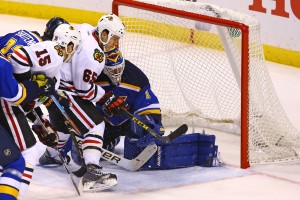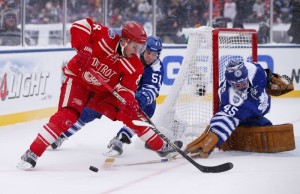Unlike so many off-seasons before this one, Stan Bowman actually won’t be forced to trade away a large portion of his roster to keep the team under the salary cap. Instead, he faces a few interesting free agent decisions on who will be back in Chicago next season, and who will be playing elsewhere.
Atop that list of interesting decisions sits Andrew Shaw: a polarizing player in the world of hockey that dealt with his fair share of controversy after he lost his cool at the end of a crucial Game 4 loss against St. Louis this postseason. Shaw seems to like playing in Chicago, a city where he has won two Stanley Cups, but ultimately it will be up to Bowman to decide if the feisty winger will return for 2016-17.
However, it isn’t as if Bowman is eager to push Shaw out of Chicago anytime soon. The fact that he has already had some discussions with agent Pat Brisson about a potential new deal for Shaw seems to indicate that re-signing the fan favorite is a priority within the Hawks front office. The issue with these discussions revolves around the price of a new contract, something Bowman needs to negotiate carefully given the large amount of money already tied up in contracts for Patrick Kane, Jonathan Toews, Brent Seabrook, Corey Crawford, and others also on the roster.
Setting the Market
Deciding how much Shaw is worth isn’t as easy as it would for most other players. His offensive numbers have always been solid for a role player (as I will discuss shortly), but some would argue that his real value to the Blackhawks is the energy and edge he provides whenever he’s on the ice.

Those qualities are incredibly tough to quantify in contract negotiations, and as such should never be the sole variable used to determine a player’s value. With that in mind, the following rough valuation will attempt to be relatively objective and leave out the intangible aspects that Shaw brings to the Hawks until the end.
The first thing I did when trying to set Shaw’s value was head to the similarity calculator over at Corsica.hockey to see which players were the closest comparisons to Shaw on the surface. After making some adjustments to the given scale so that hits, blocks, CF%, and quality of competition played larger factors than they had originally, I began to examine some of his closest comparisons.
The top returns were Beau Bennett, Justin Abdelkader, and Rickard Rakell, but it was clear to me that Bennett and Rakell were not suitable comparisons for Shaw due to their limited experience and Rakell’s expanding offensive role with Anaheim. Abdelkader seemed like a fair comparison, however, and I kept him on a list that also included Michael Raffl and Anders Lee.

One thing that stood out to me when I began comparing these players on a deeper level was the amount of misconceptions people seemed to have about Shaw as a hockey player. For instance, while his hit totals seem to indicate that he was playing without the puck a lot (it’s tough to hit another player when you’re the one with the puck), he actually posted the second best CF% of these four players over the past three seasons.
And while his playoff drama clearly painted Shaw as an undisciplined player prone to taking poor penalties and putting his team a hole, he actually had a +6 penalty differential over the past three regular and post seasons (according to war-on-ice.com). For a Chicago power play that converted on 20% of their opportunities since 2013, that differential can be an incredibly valuable source of goals.
The unfortunate part about comparing him to a player like Abdelkader is having to look at the massive contract that Detroit gave the winger this season. He received a mind-boggling 7-year, $30 million deal that seemed to be mostly based on the grit and physicality he offered their lineup on a regular basis. It hasn’t gone well so far for Detroit.
Callahan and Abdelkader in that scrum throwing wildly. Hopefully also debating who has the worse contract.
— Travis Yost (@travisyost) April 16, 2016
The long-term investment in Abdelkader was clearly not a good one for any team to make, and should serve as a cautionary example when the Blackhawks look to re-sign Shaw.
Placing a Value on Shaw’s Contract
The hard part for Bowman will come not in determining whether Shaw is a valuable player, but placing a price on that value that his team can afford. Unfortunately for him, Joel Quenneville didn’t seem to make his job any easier when he claimed that Shaw was an ‘irreplaceable’ player on the team.
#Blackhawks' Joel Quenneville says Andrew Shaw is 'irreplaceable' https://t.co/aWGS1Dvhi8
— Second City Hockey (@2ndCityHockey) April 27, 2016
Also not helping his cause is Marcus Kruger’s new contract that apparently indicates that the center is worth more than $3 million per year for the Blackhawks. Shaw won’t have a hard time arguing that he is worth more than Kruger when directly comparing their production, especially given the similar versatility each player possesses when it comes to playing the center ice position.
I wouldn’t disagree with that claim from Shaw’s camp, but I also wouldn’t give him anywhere near the $4.25 million per year that Abedelkader is making. Instead, I would put him right around the $3.5 million range, or roughly $1 million more than what Raffl received from the Flyers in his latest extension.
Shaw is still a younger player than Raffl was when he signed that extension, and his skill and experience definitely make him worth more than Philadelphia’s depth winger. Additionally, Shaw’s grinding reputation occasionally overshadows the fact that he can make plays like the one below. A confidence boost from a new contract might even make those plays a little more commonplace for a player that certainly has a lot to prove after the way his postseason ended.
With all things considered, I think the Blackhawks would be happy to give Andrew Shaw a reasonable extension (in the three year range) worth between $3.25 and $3.75 million per season. Anything in excess of that would be an overvaluation of the energy and heart he provides the team, while anything less might not be enough to satisfy Shaw’s camp after the Kruger deal.